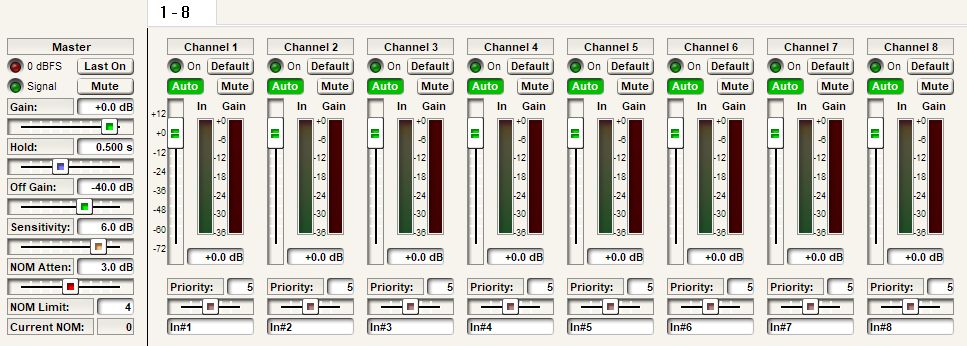Automatic mixing technology is not a new technology. Since the 1970s, various types of automatic mixers and various patents have been transformed into a function in DSP equipment. The form of the automatic mixer is gradually changing from an independent device to a virtual programming algorithm. Although the software algorithms of various companies will not be announced, we can better understand and use the automatic mixing function in the DSP by understanding the core technology and principles of the automatic mixer.

A meeting room of tens of square meters often needs to plug a dozen or more microphones. Sound engineers will encounter a phenomenon when debugging: one microphone is debugged to no whistle, but when two or more microphones are turned on, they will whistle inexplicably. This is also a law often mentioned by audiophiles: the number of open microphones doubles, and the system gain increases by 3dB, that is, NOMG (Number of Open Microphone Gain) = 10lg (NOM).
Automatic mixing technology
The microphone is automatically turned on or off according to the level, which can automatically balance the system gain that is doubled by the number of microphones turned on. In fact, it is very similar to the first method, except that people become equipment at this time. At this time, it can reduce the number of microphones. The need for margin, and the microphone is in the form of a gooseneck microphone, the final sound will be much better than the conference system. But in fact, the single automatic mixer is actually similar to the conference system, and it is finally mixed all the way to processing. Equipment for processing. This form of processing actually has the same problems as the conference system. Therefore, we generally recommend to customers to use DSP equipment with automatic mixer function. Each microphone can be adjusted accurately, so that the sound quality is optimized. At the same time, some have the direct output function of automatic mixer, which can be easily done. To MIX-MINUS, this is almost impossible with ordinary automatic mixers or conference systems. And because it can combine the rich functions of the DSP itself, many conference system functions such as chairperson priority, request to speak, camera tracking, etc. can be realized.
The automatic mixer needs to have 2 basic elements: 1. When and how to turn the microphone on and off; 2. How to balance the NOM gain. Technically, it can be divided into two categories: Gating and Gainsharing automatic mixers.
The Gating automatic mixer, as its name implies, has a threshold to control the switch of the microphone. If the sound exceeds the threshold, the microphone will be turned on, and if the sound is below the threshold, the microphone will be turned off. How to get the best threshold (Threshold)?
Fixed threshold: The simplest and most common is to use a voice trigger switch or noise gate to set a fixed value. If this value is exceeded, the microphone will be turned on, and if it is lower, the microphone will be turned off. Usually this value can be adjusted, but it cannot be adjusted by itself according to the environmental noise, so the result is often not satisfactory.
In many cases, if the setting is too small, ambient noise, clapping, and certain music sounds can easily turn on the microphone. If the setting is too high, it is easy to eat words or sound jams. Another problem when using noise gates and other devices is that when the whole applause occurs, all microphones are turned on, and the system is extremely prone to howling. Due to the simple implementation of fixed thresholds and low cost, many automatic mixers and software-based automatic mixers still use similar methods to make decisions, and the final effect is often very poor.
Adaptive threshold: Since it is difficult to obtain better results with fixed thresholds, various manufacturers have successively introduced their own adaptive threshold circuits or algorithms, which can obtain new thresholds in real time based on environmental noise, and the final effects are also different.
So from the perspective of engineers, we need to understand and know what parameters of the Gating automixer can be controlled in order to achieve it well!

Last On: Last On ensures that even if no voice is detected, the microphone that spoke last will remain open. This function can ensure that the speaker cannot turn on the microphone when the level is lower than the threshold during the sentence interval, so as to avoid the problem of losing the prefix when speaking. Mute: The overall output of the automixer is muted. Gain: The overall output level gain of the automatic mixer. Hold: The Hold function can adjust the length of time the channel remains open after the speaker stops speaking. This function ensures that the short pause between words and sentences when the speaker is speaking will not cause the channel to be closed. Off Gain: Disconnect the level of the channel. For example, when microphone 1 is turned on first while speaking, and microphone 2 is turned on to speak, then microphone 2 will gain gain, but the gain is microphone 2’s speech level plus the value set by Off Gain. Too high a setting value will cause the microphone that is not turned on to receive room noise and reverberation. A setting value that is too low will make the microphone 2 unable to output a sufficient level. Sensitivity: Sensitivity control. When the adaptive noise threshold of the channel is exceeded, the channel must be turned on. If the value of this setting is increased, the channel will be easily turned on under very quiet noise. In my experience, a noisy room requires a lower setting value than a quiet room. Because in a quiet room, even very low-level sounds will be much higher than the background noise. NOM Atten: The NOM attenuation fader can affect the amount of attenuation for all channels when more microphones are turned on. This parameter reflects the attenuation when the two microphones are turned on, and the additional attenuation that will increase after each doubling of the number of microphones turned on. For example, when set to 3dB, two microphones will be attenuated by 3dB, four microphones will be attenuated by 6dB, and eight microphones will be attenuated by 9dB. In the same way, if the number of microphones is doubled, the output attenuation value will increase by 3dB. NOM Limit: Set the maximum number of microphones to be turned on. Channels that are not in Auto mode or have been muted are not included.
After understanding the meaning of each parameter, it is much simpler to implement. Then the only difficulty lies in the acquisition of the automatic threshold.
Our other product:

















